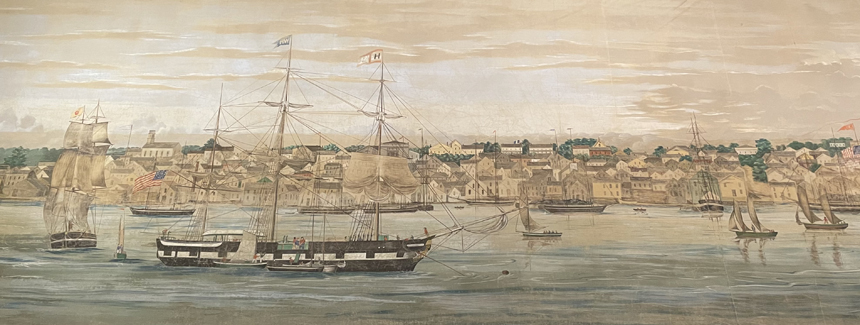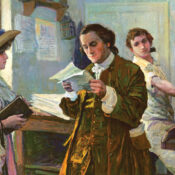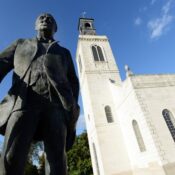This series by American studies professor Ben Railton explores the connections between America’s past and present.
This past weekend, I got married on Cape Cod. I’ve had the chance in this column to share some of the most important people in my life, including my parents and my sons, and the Cape is one of the most significant places for all those people. My paternal ancestors include a fisherman who made his living on Martha’s Vineyard in the early 20th century; my paternal grandfather Arthur Railton fell in love with the island through that relative, retired there with my grandmother in the 1970s, and ended up publishing the definitive history of Martha’s Vineyard when he was in his 90s. The whole area is hugely meaningful for the Railton family, and it was wonderful to add to those meanings with this special event.

I wanted to share that event and those connections with you all through my Considering History column, and decided to do so by highlighting one of the area’s most important and inspiring people: Paul Cuffe (1759-1817). This multiracial mariner and merchant became one of the most interesting and influential figures in Revolutionary and Early Republic Massachusetts and America, and his life and legacy have a great deal to teach us about both those foundational periods and our shared national story.
Cuffe was born on Cuttyhunk, the outermost of the Elizabeth Islands that are located just northwest of Martha’s Vineyard; Cuttyhunk’s 1602 sassafras farming community makes it the oldest English settlement in New England. Cuffe’s mother Ruth Moses was a Wampanoag Native American from the Cape Cod town of Harwich; his father Kofi (sometimes spelled Coffe) Slocum was an Ashanti man who was born in Africa and kidnapped into slavery at the age of 10, but had been freed by his slaveowner, the merchant John Slocum, in 1745 and had married Ruth two years later. Kofi passed away in 1772 when Paul was only 13, and Paul and his older brother John took over running the family farm in the coastal town of Dartmouth and changed their last name to Cuffe to honor their father.
Like many young men born in coastal New England in the 18th century, however, Paul Cuffe was seemingly called to the sea, and just a year after his father’s death he sailed on a whaling ship for the first of what would be three voyages over the next few years. As the excellent New Bedford Whaling Museum documents, from the mid-18th century to the mid-19th century whaling was one of America’s most successful industries, and whaling ships were also one of the era’s most multicultural and integrated communities. Although Cuffe’s time in the world of whaling was relatively brief, he was heavily influenced by it: He gained experience as a mariner, which would lead to a future as both ship’s captain and shipbuilder; and was also exposed to diverse communities, which would contribute to Cuffe’s social and political activism.

During the American Revolution, Cuffe would begin each of those next stages of his life. In 1777 he was working as a seaman about the Charming Polly when she was captured by the British, and he and the rest of the crew spent a few months in prison in New York. The experience seems only to have emboldened Cuffe: In 1779, as the 20 year-old captain of his own small sailboat, he slipped past a British blockade to deliver goods to Nantucket, a feat he would repeat throughout the rest of the Revolution. Young Cuffe’s revolutionary activism did not only target the British, as just a year later he and his brother John refused to pay taxes to protest free Blacks being denied the right to vote in Massachusetts. Their 1780 petition to gain that right was denied, but is credited as a significant influence on the legislature’s 1783 decision to enfranchise all free male citizens.
In the decades after the Revolution, Cuffe extended and deepened each of these layers of his revolutionary life. In 1783 he married Alice Abel Pequit, a Wampanoag woman; the two would settle in the coastal town of Westport and raise seven children together. During these same years, Cuffe started a shipbuilding business with his brother-in-law Michael Wainer (a Native American and the husband of Cuffe’s older sister Mary), and the two built that business into one of the early 19th century’s most successful and influential commercial ventures. When Cuffe himself captained one of their ships, the brig Traveller, on an 1811 voyage to Liverpool, the London Times noted it was “perhaps the first vessel that ever reached Europe, entirely owned and navigated by Negroes.”

The maritime industry was far from the only setting that Paul Cuffe helped integrate. As described in a biography of Cuffe written by members of the Delaware Abolitionist Society (with whom he visited in Wilmington in 1807), “Paul had experienced the many disadvantages of his very limited education, and he resolved, as far as it was practicable, to relieve his children from similar embarrassments.” In 1797 he did so quite directly, building and opening a schoolhouse on land adjacent to his own Westport home and making it both free of charge and “open to all who pleased to send their children,” including free Blacks, Native Americans, and whites. Cuff’s School, as it came to be known, was thus by all accounts the first racially integrated school in the United States.
Two early 1810s events in Cuffe’s life reflect the complex question of whether Early Republic America could become as integrated as his groundbreaking school. Beginning in 1810, Cuffe was recruited first by British abolitionists and later by members of the American Colonization Society (ACS) to explore whether the African colony of Sierra Leone offered suitable conditions for the resettlement of free Blacks from these nations. Cuffe voyaged to Sierra Leone frequently over the remaining seven years of his life and worked hard to support newly established Black settlements there, yet at the same time he never fully endorsed the ACS’s vision of colonization. That hesitancy was due to both Cuffe’s own recognition of the colonization movement’s racism and his conversations with fellow free Black Americans, an Early Republic community in which he was highly influential.
The colonization question was also part of what brought Cuffe to an April 1812 meeting at the White House with President James Madison, making Cuffe the first Black American to formally meet with a sitting president. Cuffe and Madison also talked about Cuffe’s status as an American merchant in a fraught historical moment: Cuffe’s ships were continuing to do business around the world despite a newly imposed War of 1812 U.S. embargo on British shipping. Cuffe convinced Madison he had not violated the embargo, and this captain who had once run British blockades to aid the American Revolution was deemed free to continue building his Early Republic shipping empire. Tragically, Cuffe would pass away only a few years later, in 1817, but the legacies of that business, as of his school, his political activism, and his pan-African interests, would carry on.
Become a Saturday Evening Post member and enjoy unlimited access. Subscribe now



